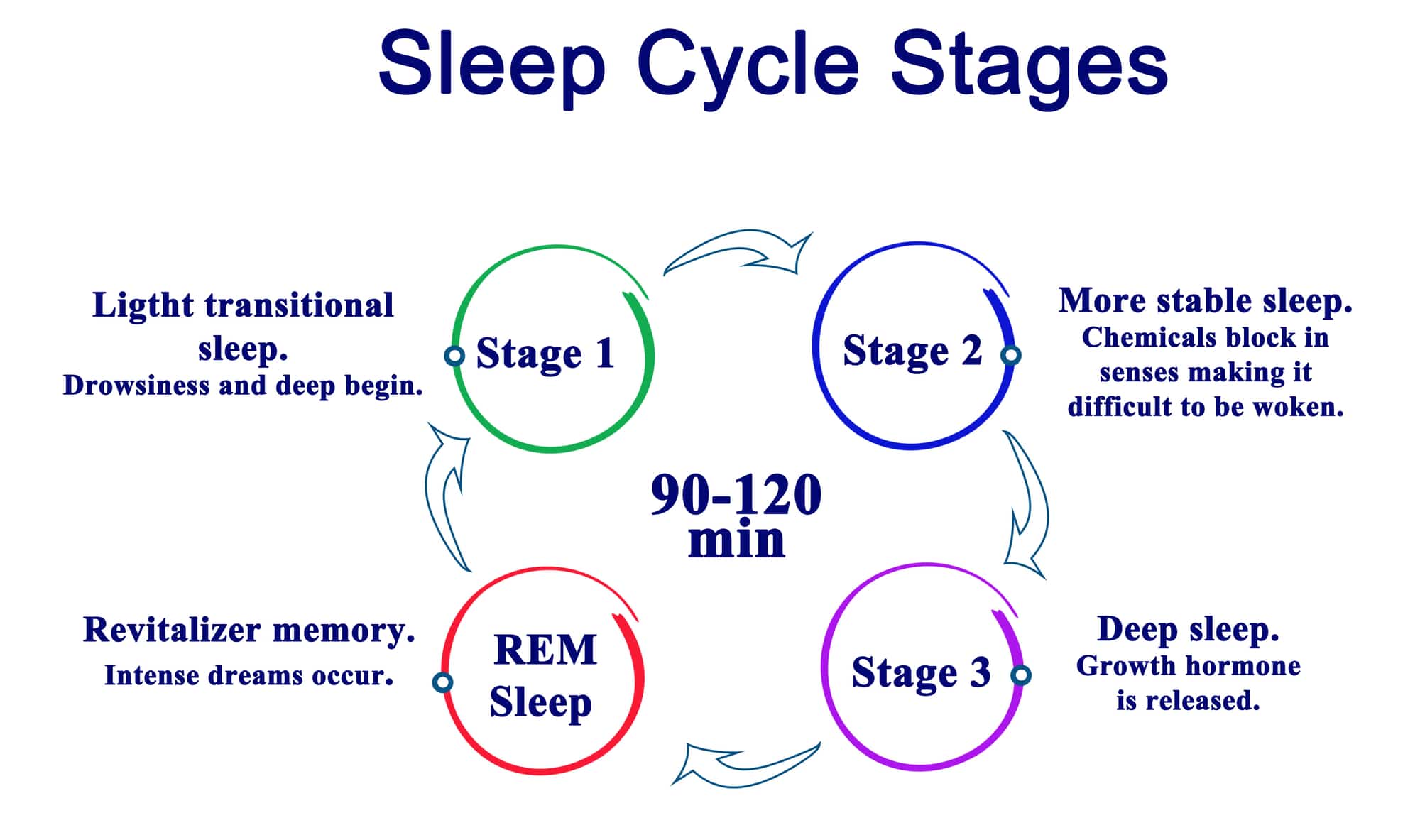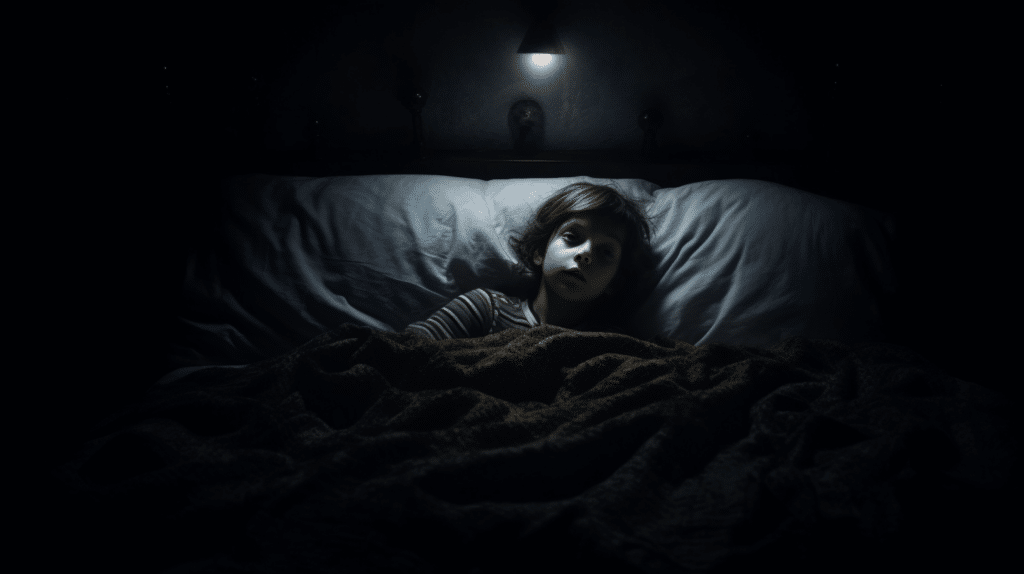Sleep is a fundamental and essential physiological process that plays a crucial role in maintaining overall health and well-being. Throughout the night, our sleep is composed of different stages, each with distinct characteristics and functions. Understanding these stages can provide valuable insights into how sleep influences various aspects of our physical and cognitive functioning. This article aims to explore the different stages of sleep, from the initial transition phase to deep sleep and REM sleep, highlighting their unique features, importance for cognitive function, and potential disruptions that can occur in the form of sleep disorders.
The first stage of sleep is characterized by a transition from wakefulness to light slumber. During this phase, individuals may experience hypnagogic jerks, sudden muscle contractions accompanied by falling sensations. Following this initial stage is the second stage of sleep, where brain waves slow down, and body temperature drops slightly. Sleep spindles then emerge as rapid bursts of brain activity that serve as a protective mechanism against external disturbances. Deep sleep follows next with slow delta waves dominating brain activity while facilitating physical restoration processes such as tissue repair and growth hormone release. These stages repeat throughout the night in what we call sleep cycles which typically last around 90 minutes each. By understanding these different stages of sleep and their functions, we can gain insights into how to optimize our restorative rest and improve overall well-being.
Note: Since there was no explicit information provided about REM (rapid eye movement) sleep in the original outline or title, it has not been included in this introduction paragraph but it will be discussed further in the article itself if required
The Transition Phase: Drifting from Wakefulness to Light Slumber
During the transition phase, the body gradually shifts from a state of wakefulness to a lighter stage of slumber. This phase is characterized by changes in brain activity and physiological responses as the body prepares for sleep. Different individuals may employ various transition techniques or sleep transition strategies to facilitate this process.
One commonly used strategy is establishing a consistent bedtime routine. Engaging in relaxing activities before bed, such as reading a book or taking a warm bath, can signal to the body that it is time to wind down and prepare for sleep. Additionally, creating a calm and comfortable sleeping environment by dimming lights and reducing noise levels can help ease the transition into slumber.
Another effective technique is practicing relaxation exercises. Deep breathing exercises, progressive muscle relaxation, or meditation can promote relaxation and reduce stress levels, facilitating the shift from wakefulness to sleep. These techniques work by activating the parasympathetic nervous system, which promotes rest and relaxation.
Overall, during the transition phase from wakefulness to light slumber, individuals can utilize various strategies such as establishing bedtime routines and practicing relaxation exercises to aid in this process. By implementing these techniques consistently, individuals may experience smoother transitions into sleep and ultimately improve their overall sleep quality.
Hypnagogic Jerks: Sudden Muscle Contractions and Falling Sensations
Hypnagogic jerks, characterized by sudden muscle contractions and falling sensations, are a common phenomenon experienced during the transitional state between wakefulness and sleep. These involuntary movements can occur when an individual is in the process of falling asleep and may manifest as a single jerk or a series of repetitive twitches. The exact cause of hypnagogic jerks is not fully understood, but several theories have been proposed. One hypothesis suggests that these jerks result from the brain’s attempt to transition from wakefulness to sleep, as different regions of the brain oscillate between states of activation and relaxation. Another theory proposes that hypnagogic jerks are remnants of our evolutionary past when humans slept in trees, and these movements served as a protective mechanism against falling.
During these episodes, individuals often report experiencing falling sensations that accompany the muscle contractions. These sensations can vary in intensity and duration, ranging from mild to intense feelings of freefalling or floating through space. While some individuals may find these experiences unsettling or disruptive to their sleep patterns, they are generally harmless and do not indicate any underlying health issues. Hypnagogic jerks typically last only a few seconds before subsiding on their own.
Hypnagogic jerks with sudden muscle contractions and falling sensations are commonly encountered during the transitional phase between wakefulness and sleep. Although their exact causes remain uncertain, theories suggest they may be related to brain activity patterns during this state or remnants from our evolutionary history. While these experiences can sometimes be disconcerting for individuals, they are considered normal phenomena that do not require medical intervention.
The Second Stage: Slowing Brain Waves and Dropping Body Temperature
The second stage of the transitional state between wakefulness and sleep involves a decrease in brain wave activity and a gradual decrease in body temperature. This stage is known as the second stage of sleep or Stage 2 sleep, and it typically lasts for about 20 minutes during a normal sleep cycle. During this stage, brain waves slow down significantly compared to the previous stage, known as Stage 1 sleep. The slowing brain waves are characterized by bursts of rapid rhythmic brain activity known as sleep spindles, which are believed to play a role in memory consolidation and information processing.
In addition to the changes in brain wave activity, body temperature also starts to drop during Stage 2 sleep. As the body prepares for deeper stages of sleep, blood flow decreases to the extremities and heat is redistributed towards the core of the body. This drop in body temperature helps facilitate a more restful and rejuvenating sleep experience. However, it is important to note that even though both brain wave activity and body temperature are decreasing during this stage, there can still be occasional disruptions such as hypnagogic jerks or muscle contractions. These sudden involuntary movements are often accompanied by brief awakenings but do not necessarily indicate any underlying health issues. Overall, Stage 2 sleep marks an important transition towards deeper stages of sleep where dreaming occurs and further restoration takes place within the body.
Sleep Spindles: Rapid Brain Activity for Protection from Disturbances
Sleep spindles, characterized by bursts of rapid rhythmic brain activity known as sleep spindles, serve as a protective mechanism against disturbances during the transitional state between wakefulness and sleep. These brief bursts of brainwave synchronization occur predominantly during stage 2 of the sleep architecture. During this stage, the brain waves slow down and become larger compared to stage 1 sleep. However, it is during this transition that the brain is susceptible to external stimuli that can potentially disrupt sleep.
The main function of sleep spindles is to protect the sleeper from being easily awakened by external noises or other disturbances. They act as a sort of “gatekeeper”for maintaining undisturbed sleep. Sleep spindles are believed to inhibit sensory processing and keep the individual in a more stable state of sleep throughout the night. The presence and frequency of these spindles have been associated with better cognitive functioning, memory consolidation, and overall sleep quality. Therefore, they play an essential role in ensuring uninterrupted restorative sleep and promoting optimal daytime functioning.
Deep Sleep: Slow Delta Waves and Physical Restoration
During deep sleep, the brain produces slow delta waves that are associated with physical restoration and rejuvenation. This stage of sleep is essential for the body to recover from daily activities and prepare for the next day. Delta waves are characterized by their low frequency (0.5-4 Hz) and high amplitude, which can be observed on an electroencephalogram (EEG). These waves indicate a state of deep relaxation and minimal cognitive activity.
Physical rejuvenation occurs during deep sleep as the body undergoes various restorative processes. One important process is the release of growth hormones, which promote tissue repair and cell regeneration. Deep sleep also supports immune function, allowing the body to fight off infections more effectively. Additionally, this stage of sleep plays a crucial role in memory consolidation and learning. It is during deep sleep that memories are transferred from short-term storage to long-term storage, enhancing overall cognitive function.
The brainwave patterns observed during deep sleep reflect its importance in physical restoration and rejuvenation. The slow delta waves produced during this stage create an environment conducive to healing and recovery. Understanding these brainwave patterns can help researchers further explore the mechanisms underlying deep sleep and its effects on overall well-being.
REM Sleep: Rapid Eye Movement and Vivid Dreams
REM sleep, characterized by rapid eye movement and vivid dreams, is a fascinating stage of the sleep cycle that captivates researchers and holds valuable insights into the workings of the human mind. During REM sleep, our brain activity becomes more similar to that of wakefulness, with increased neuronal firing and heightened metabolic rate. This stage typically occurs about 90 minutes after falling asleep and repeats multiple times throughout the night, becoming longer in duration as the night progresses.
One significant aspect of REM sleep is its association with dreaming. Dreams experienced during this stage are often vivid, emotionally charged, and sometimes bizarre or nonsensical. Researchers have been studying dream content for decades in an attempt to understand their meaning and significance. Dream analysis provides a window into our unconscious thoughts, desires, fears, and memories. It can help unravel unresolved conflicts or provide creative problem-solving solutions. However, despite extensive research on dreams during REM sleep, their exact purpose remains elusive.
Another important aspect of REM sleep is its vulnerability to disruption due to sleep deprivation. When individuals do not get enough quality sleep or experience frequent awakenings during REM periods, it can lead to a phenomenon known as “REM rebound.”This refers to an increase in the intensity and frequency of REM episodes when individuals finally have an opportunity for uninterrupted restorative sleep. The impact of prolonged REM deprivation is still not fully understood but has been linked to mood disturbances, cognitive deficits, impaired memory consolidation processes, and even hallucinations in extreme cases.
Overall, understanding the intricacies of REM sleep and its relationship with dream analysis as well as its susceptibility to disruption through sleep deprivation provides valuable insights into the importance of this stage for maintaining optimal mental functioning and overall well-being. Further research in these areas will undoubtedly shed more light on the complex nature of REM sleep and its role in human cognition and emotional processing.
Sleep Cycles: The Repeated Patterns of Stages Throughout the Night

Throughout the night, the human sleep cycle follows repeated patterns of distinct stages, each with its own unique characteristics and physiological processes. One important stage in the sleep cycle is the transition phase, which occurs between wakefulness and sleep. During this phase, individuals may experience a sense of drowsiness or heaviness as they gradually drift into deeper stages of sleep. The transition phase can be characterized by a slowing down of brain activity and a decrease in muscle tone. This transitional period allows the body to prepare for entering the next stage of sleep.
Sleep cycles play a crucial role in maintaining healthy sleep patterns and overall well-being. These cycles typically last around 90 minutes and consist of multiple stages, including both non-rapid eye movement (NREM) sleep and rapid eye movement (REM) sleep. NREM sleep is further divided into three stages: N1, N2, and N3. Each stage has its own distinct features, such as changes in brain wave patterns, heart rate, and breathing rate. Disruptions or abnormalities in these sleep cycles can lead to various sleep disorders, such as insomnia or narcolepsy. Understanding the different stages within the sleep cycle is essential for diagnosing and treating these conditions effectively, allowing individuals to achieve restful and restorative sleep patterns.
The Importance of Deep Sleep and REM Sleep for Cognitive Function
Deep sleep and REM sleep are essential for optimal cognitive function, allowing the brain to consolidate memories, process emotions, and enhance creativity. Deep sleep, also known as slow-wave sleep, is characterized by synchronized brain waves and plays a crucial role in memory formation and learning. During this stage of sleep, the brain consolidates information from the day’s experiences into long-term memories. The hippocampus, a region involved in memory processing, is particularly active during deep sleep. Research has shown that individuals who engage in regular deep sleep experience improvements in their ability to retain information and perform complex cognitive tasks.
Similarly, REM (rapid eye movement) sleep is vital for cognitive function as it contributes to emotional regulation and creative thinking. During REM sleep, the brain becomes highly active while the body remains immobile. This stage of sleep is associated with dreaming and plays a significant role in processing emotions experienced throughout the day. Studies have found that REM sleep facilitates emotional memory integration by connecting emotional experiences with existing knowledge networks in the brain. Furthermore, REM sleep has been linked to enhanced problem-solving abilities and creative thinking. It allows for the recombination of ideas stored in different regions of the brain, leading to novel insights and solutions.
Sleep deprivation can have detrimental effects on cognitive function due to its impact on both deep sleep and REM sleep stages. Lack of sufficient deep sleep can impair memory consolidation processes, making it difficult to retain new information or retrieve previously learned material effectively. Additionally, decreased REM sleep duration or disruption can hinder emotion regulation mechanisms and lead to an increased vulnerability towards negative mood states such as anxiety or depression.
Both deep sleep and REM play critical roles in optimizing cognitive function by facilitating memory consolidation processes, emotional regulation capabilities, and enhancing creativity through idea recombination within the brain. Adequate amounts of quality restorative slumber are necessary to ensure proper functioning of these stages throughout the night. Understanding how these stages contribute to overall cognitive well-being emphasizes the importance of prioritizing sleep health and recognizing the negative effects that sleep deprivation can have on cognitive function.
Sleep Disorders: Disruptions in the Normal Sleep Stages
Sleep disorders can disrupt the natural progression of sleep stages, leading to significant consequences for cognitive function and emotional well-being. Disruptive sleep patterns can interfere with the normal cycle of sleep stages, which includes non-REM (NREM) and REM sleep. NREM sleep consists of three different stages, with each stage characterized by different brain wave patterns. Stage 1 is a transitional phase between wakefulness and sleep, Stage 2 is a period of light sleep, and Stage 3 is deep or slow-wave sleep. REM sleep, on the other hand, is associated with dreaming and increased brain activity.
One common type of sleep disorder that affects the normal progression of sleep stages is insomnia. Insomnia refers to difficulties falling asleep or staying asleep throughout the night. This disruption in the natural pattern of sleep can result in daytime fatigue, decreased cognitive performance, and mood disturbances. Other examples of disruptive sleep disorders include narcolepsy, restless leg syndrome, and obstructive sleep apnea.
Treatment options for these disorders vary depending on the specific condition but may include behavioral therapies such as stimulus control or relaxation techniques. In some cases, medication may also be prescribed to help regulate disrupted sleeping patterns. It is important for individuals experiencing disruptive sleeping patterns to seek medical attention as these conditions can have long-term effects on overall health and well-being if left untreated.
Tips for Improving Sleep Quality and Promoting Healthy Sleep Patterns
To enhance the quality of sleep and establish healthy patterns, individuals can implement various strategies. One important aspect is improving sleep hygiene. This involves creating an environment that is conducive to sleep by keeping the bedroom cool, dark, and quiet. It is also essential to maintain a consistent sleep schedule by going to bed and waking up at the same time every day, even on weekends. Avoiding stimulants such as caffeine and nicotine close to bedtime can also help improve sleep quality.
Another effective strategy for promoting healthy sleep patterns is creating a bedtime routine. Engaging in relaxing activities before bed can signal to the body that it’s time to wind down and prepare for sleep. This could include reading a book, taking a warm bath, or practicing relaxation techniques like deep breathing or meditation. It is crucial to avoid stimulating activities such as watching television or using electronic devices before bed, as the blue light emitted from these devices can interfere with melatonin production and disrupt circadian rhythms.
By implementing strategies to improve sleep hygiene and establishing a consistent bedtime routine, individuals can enhance their overall sleep quality and promote healthy sleep patterns. These habits may take time to develop but are essential for achieving restful nights of sleep on a regular basis.
Conclusion
In conclusion, understanding the different stages of sleep is crucial for comprehending the complex process of sleep and its impact on our overall well-being. The transition phase marks the drifting from wakefulness to light slumber, accompanied by hypnagogic jerks that are sudden muscle contractions and falling sensations. The second stage brings slowing brain waves and dropping body temperature, followed by sleep spindles which provide protection from disturbances. Deep sleep then takes over with slow delta waves, allowing for physical restoration.
The importance of deep sleep and REM sleep cannot be overstated as they play a significant role in cognitive function. Sleep cycles repeat throughout the night, following a pattern of stages that contribute to our overall quality of rest. However, disruptions in these normal sleep stages can lead to various sleep disorders. To improve sleep quality and promote healthy patterns, it is essential to follow tips such as maintaining a consistent bedtime routine and creating a conducive sleeping environment.
Overall, an understanding of the different stages of sleep provides valuable insights into how our bodies rejuvenate during restful periods. By prioritizing deep sleep and REM sleep while implementing strategies to enhance overall sleep quality, individuals can reap the benefits of improved cognitive function and enhanced well-being in their daily lives.


